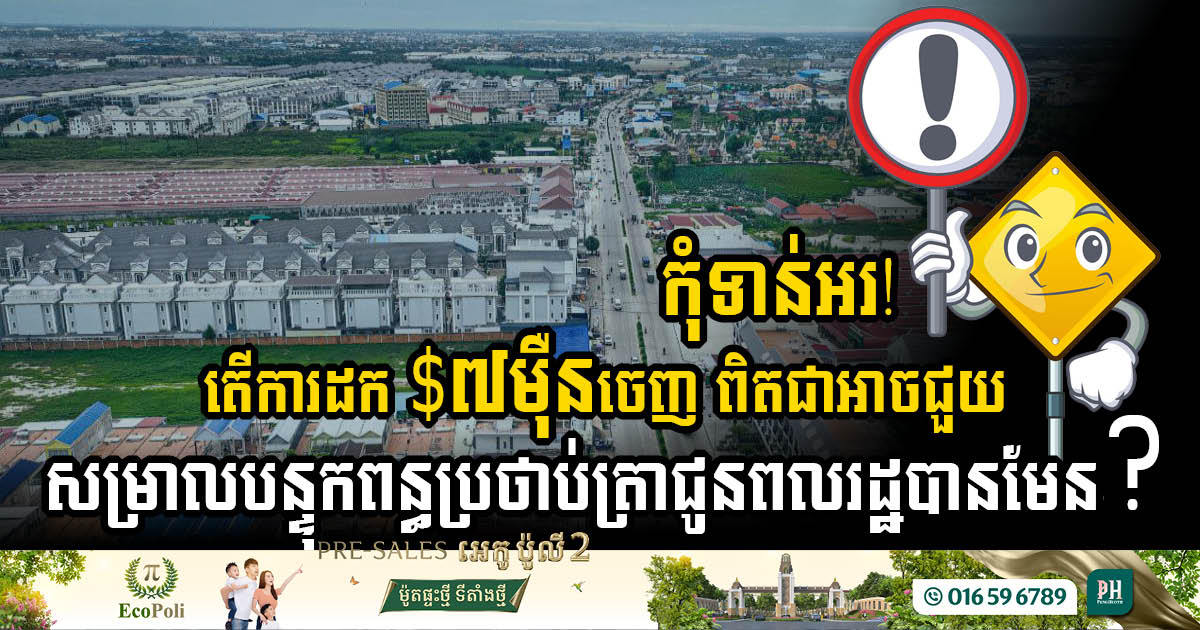Critical Analysis of Cambodia’s Stamp Duty Exemption Policy for Properties Valued at USD 70,000 or Less
The Cambodian government’s decision to introduce a stamp duty exemption for properties valued at USD 70,000 or less is a policy aimed at alleviating the financial burden on property buyers and stimulating the real estate market. However, while this policy appears beneficial on the surface, a deeper analysis reveals both advantages and disadvantages that raise questions about its overall efficacy.
Advantages
- Encourages Affordable Housing Transactions: By exempting properties valued at USD 70,000 or less, the policy reduces the financial barriers for middle- and lower-income families to purchase property. This exemption can stimulate demand for affordable housing, creating opportunities for first-time homebuyers and promoting inclusivity in the property market.
- Tax Deduction for Higher-Value Properties: For properties valued above USD 70,000, deducting USD 70,000 before calculating stamp duty can reduce the overall tax liability. This mechanism provides partial relief for buyers of mid-range and high-value properties, making real estate investment more attractive.
- Stimulates the Real Estate Market: The policy could rejuvenate a real estate market that is still recovering from the economic impacts of the COVID-19 pandemic by encouraging both transactions and construction activity in the lower- and mid-tier property sectors.
- Simplified Tax Calculation: The clarity of the USD 70,000 threshold simplifies the tax process for many buyers, reducing potential confusion or disputes over property value assessments.
Disadvantages
- Market Valuation vs. Tax Department Valuation: The disparity between the Tax Department’s property valuation scale and actual market prices introduces significant inconsistencies. Buyers with properties valued higher on sale documents but lower on tax scales face higher tax burdens, undermining the policy’s intent. For example, a property valued at USD 200,000 on sale documents incurs a stamp duty of USD 5,200 after the USD 70,000 deduction, compared to USD 1,200 if the tax scale value is applied. This discrepancy penalizes buyers who declare actual market prices.
- Unintended Tax Burden on Higher-Value Properties: While the policy aims to offer relief, buyers of high-value properties ultimately pay disproportionately higher taxes when market prices are used for calculations. This may discourage transparency in reporting sale prices, incentivizing the undervaluation of property.
- Limited Impact on Mid-to-High Market Segments: The policy predominantly benefits affordable housing, providing limited relief for buyers in mid to high-value market segments. These buyers still face substantial tax burdens despite the USD 70,000 deduction. The USD 70,000 deduction, while beneficial for affordable housing, offers limited relief to buyers in the mid-to-high market segments. This is because the deduction becomes less significant as the property’s value increases.
Example:
- Affordable Housing: A property valued at USD 100,000 would benefit significantly from the deduction. After the USD 70,000 exemption, only USD 30,000 would be subject to the 4% stamp duty, resulting in a tax of USD 1,200.
- Mid-Market Segment: A property valued at USD 200,000 would still have a taxable amount of USD 130,000 after the deduction. At a 4% stamp duty rate, this would result in a tax of USD 5,200.
- High-End Market: A property valued at USD 500,000 would have a taxable amount of USD 430,000 after the deduction, leading to a significant stamp duty of USD 17,200.
As we can see, the higher the property value, the less impactful the USD 70,000 deduction becomes. While it relieves lower-value properties, it does not significantly reduce the tax burden for mid-to-high-end properties. This disparity can create a situation where buyers in the higher market segments feel that they are not benefiting as much from the policy despite the government’s intention to stimulate the real estate market.
- Risk of Market Distortion: Developers and sellers may adjust property pricing strategies to fall just below the USD 70,000 threshold, leading to artificial pricing in the affordable housing segment. This could distort the market and create inefficiencies.
- Volatility of Real Estate Prices: As real estate prices fluctuate significantly due to market conditions, the policy may fail to adapt to changing realities. Properties that qualify for the exemption today might not qualify in the future, reducing the long-term stability of this benefit.
Weighing the Benefits and Drawbacks
The policy’s primary strength lies in its ability to encourage affordable housing transactions, which is crucial for economic recovery and inclusivity. However, its weaknesses—particularly the inconsistency in property valuation and the higher tax burden for transparent buyers—significantly undermine its advantages.
From a broader perspective:
- The advantages of stimulating the affordable housing market and offering partial tax relief weigh positively for buyers at the lower end of the spectrum.
- However, the disadvantages of market distortions, limited applicability for mid- and high-value properties, and the misalignment between tax valuations and market realities create systemic challenges.
Conclusion and Recommendations
However, since the new tax exemption policy is only valid until the end of 2025, as outlined in Notification No. 014 dated 9 October 2024, from the Ministry of Economy and Finance, it is essential to wait until the deadline to evaluate the overall results. Based on this experience, we can consider the following improvements to tax measures for future implementation, specifically:
- Align Valuation Methods: Introduce a standard valuation method that reflects real market conditions, ensuring fairness in tax calculations.
- Adjust Thresholds Dynamically: Periodically review and adjust the USD 70,000 threshold based on inflation and real estate market trends.
- Target Broader Market Segments: Offer additional tiers of tax relief for mid-range property transactions to enhance the policy’s inclusivity.
- Promote Transparency: Implement measures to encourage honest property valuation declarations without penalizing transparency.
The policy has potential but needs further adjustments to achieve its intended benefits without disproportionately burdening certain market segments. The disadvantages weigh slightly more heavily than the advantages due to practical implementation challenges. Addressing these issues would ensure a more equitable and effective approach to real estate taxation in Cambodia.
- Video Advertisement -



 ខ្មែរ
ខ្មែរ







